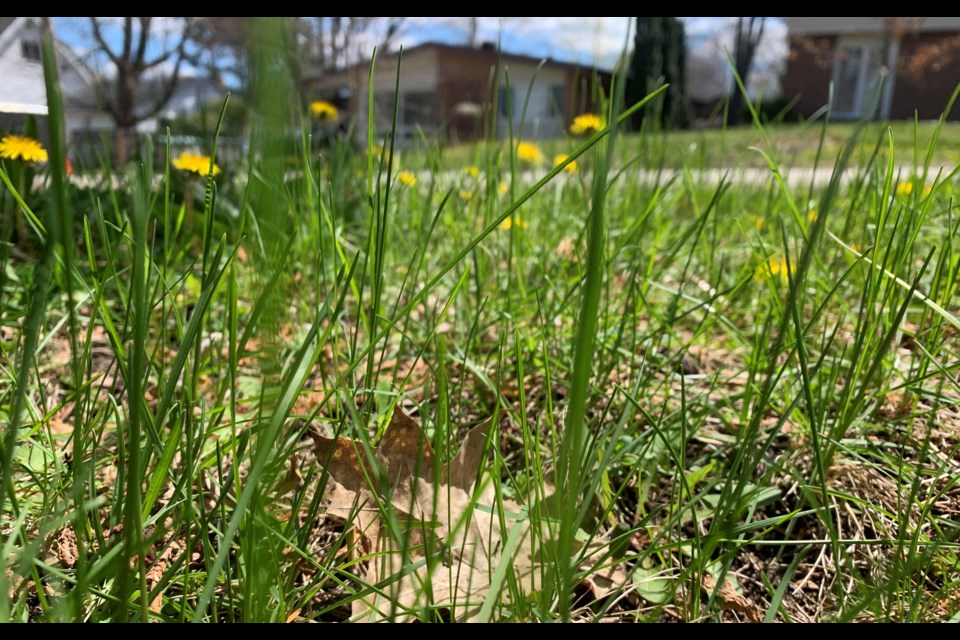It's a chore that most of us would love to put off, and now the Nature Conservancy of Canada has given us a good reason not to mow our lawns.
Using the catchy slogan, “No Mow May” "the organization is asking people to wait the rest of the month before busting out their lawnmower. It's all an effort to help with biodiversity
The Conservancy says the campaign started in the U.K. and is now picking up steam in Canada as a way to help wild pollinators and other wildlife.
With habitat loss and degradation as the major cause of wildlife decline, the not-for-profit land conservation organization is suggesting that keeping your lawnmower in the shed for May can benefit nature.
"If you imagine dozens and dozens of backyards doing things to improve habitat for native pollinators and migratory birds, this can have a big impact on nature and the quality of our urban ecosystems,” said Dan Kraus, NCC’s senior conservation biologist. “By letting flowers bloom on your lawn, including dandelions, you can provide an important source of nectar and pollen for wild bees, butterflies, and other pollinating insects.”
Bees and butterflies are the most familiar insect pollinators, while moths, flies, beetles, and ants are lesser-known pollinators that still play an important role according to a Conservancy release. In recent years, there has been a sharp decline in some pollinator populations due to climate change, habitat loss including the loss of native plants, and pesticides. Many of the fruits we buy or that we grow in our own gardens, including strawberries, apples, and melons, depend on pollination by wild insects.
NCC suggests delaying the first spring mow as long as possible, mowing less often, and mowing slowly to allow insects, frogs, and other wildlife to move out of the way. You can also practice “rotational mowing” to allow some patches of grass to support flowering plants. One study in the UK found that changing a mowing routine and allowing plants to flower can create enough nectar for 10 times more pollinators. It is suggested to mow your lawn every four weeks depending on how fast it’s growing, which results in a higher number of flowers on your lawn.
Kraus says that trying to increase your lawn’s diversity is important for urban nature because lawns are one of the largest green spaces in our towns and cities. Canada has an estimated 6.2 million lawns.
Fred Pinto is the President of the local group "Friends of Laurier Woods" and so has some insight on the subject.
"North Bay used to be forests until we built houses and urbanized it, so if you think of forests at this time of year there are lots of flowering plants coming up in spring and these are important to all of these pollinators that are coming out of their winter homes to feed. They are very hungry. Now we've changed the forests to lawns and by keeping them uncut a little longer it allows those flowers, like dandelions, that live in our lawns, to flower and become an important early source of food."
As the weather has warmed, Pinto says some insects, like the common eastern bumblebee, have started to come out. These are common in North Bay.
"These live in the ground with butterflies, beetles, and wasps. Very common pollinators in North Bay, are different species of flies."
Pinto says dandelions are important because they flower early.
"They also play an important role in ecology as their roots go quite deep in the ground as anyone knows who has tried to pull them out> They bring up nutrients from lower down to a higher level."
Pinto says he has a lawn and has vowed not to mow it this month." I'll just be watching it grow," he laughed.
The North Bay Mattawa Conservation Authority also encourages No Mow along the shoreline and streambanks throughout the growing season.
"In addition to helping pollinators, it’s a first step toward protecting shorelines and streambanks from erosion and runoff of unwanted nutrients which can contribute to the growth of blue-green algae," says spokeswoman Sue Buckle. "Trees, shrubs, and plants are best on the streambank or shoreline, but at the very least, leaving a no-mow buffer can help."
You can learn more about creating a vegetated shoreline and get information from a native plant guide on www.restoreyourshore.ca
A vegetated stream bank or shoreline plays a critical role in keeping watercourses and lakes healthy! They:
- purify water by filtering sediments
- capture and trap pollutants such as fertilizers, pesticides, excess nutrients
- protect against erosion of streambanks (which carries sediment into the water)
- reduce sediment (particles of soil) from entering the water (excess sediment and nutrients in water promote algae blooms and weed growth!)
- slow overland flows, promoting the infiltration of water
- protect against erosion and slow overland flow of rain and water which can assist in flood prevention!
Vegetated shorelines and streambanks also provide environmental benefits, including:
- provide wildlife corridors
- cool water temperatures for aquatic life
- provides habitat
- aesthetically appealing
Other tips on how to attract pollinators can be found here.
See the Rolling Stones sing Dandelion below.
